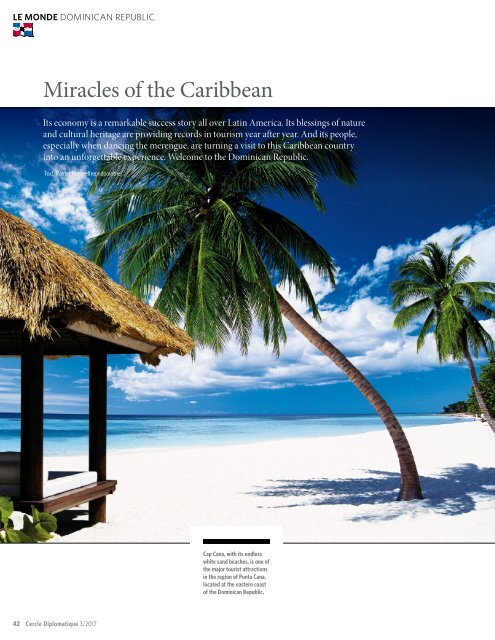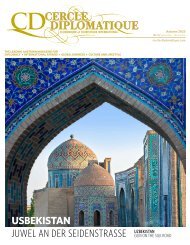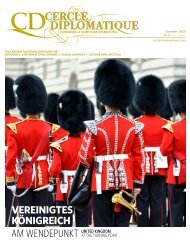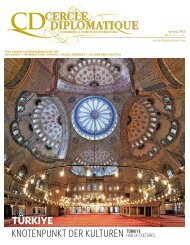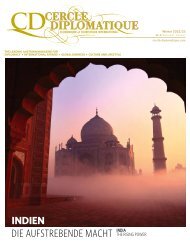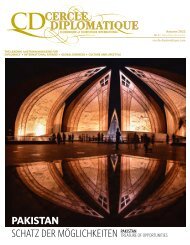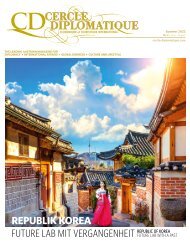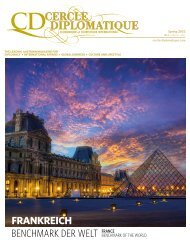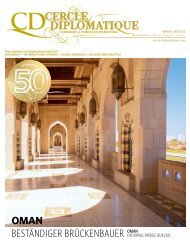CERCLE DIPLOMATIQUE - issue 03/2017
CD is an independent and impartial magazine and is the medium of communication between foreign representatives of international and UN-organisations based in Vienna and the Austrian political classes, business, culture and tourism. CD features up-to-date information about and for the diplomatic corps, international organisations, society, politics, business, tourism, fashion and culture. Furthermore CD introduces the new ambassadors in Austria and informs about designations, awards and top-events. Interviews with leading personalities, country reports from all over the world and the presentation of Austria as a host country complement the wide range oft he magazine.
CD is an independent and impartial magazine and is the medium of communication between foreign representatives of international and UN-organisations based in Vienna and the Austrian political classes, business, culture and tourism. CD features up-to-date information about and for the diplomatic corps, international organisations, society, politics, business, tourism, fashion and culture. Furthermore CD introduces the new ambassadors in Austria and informs about designations, awards and top-events. Interviews with leading personalities, country reports from all over the world and the presentation of Austria as a host country complement the wide range oft he magazine.
Create successful ePaper yourself
Turn your PDF publications into a flip-book with our unique Google optimized e-Paper software.
LE MONDE DOMINICAN REPUBLIC<br />
Miracles of the Caribbean<br />
Each year, between January<br />
and March, many big cruise<br />
ships head for the northern<br />
Samaná Bay for a whalewatching-stopover.<br />
FACTS &<br />
FIGURES<br />
Its economy is a remarkable success story all over Latin America. Its blessings of nature<br />
and cultural heritage are providing records in tourism year after year. And its people,<br />
especially when dancing the merengue, are turning a visit to this Caribbean country<br />
into an unforgettable experience. Welcome to the Dominican Republic.<br />
Text: Rainer Himmelfreundpointner<br />
PHOTOS: FOTOLIA<br />
On February 6th, 1998, the Austrian singer<br />
and pop star Falco – eventually the country‘s<br />
most outstanding musician in recent decades<br />
who has spent his last year in the Dominican Republic<br />
to finish a new album – has deceased after a<br />
car crash near the city of Monte Llano in the Dominican<br />
Republic. Up until now, some of his fans pay<br />
tribute at a little memorial site which has been set up<br />
there on the Caribbean island.<br />
As sad as this lethal accident has been, it carries a<br />
truth within that is distinctly und definitely positive<br />
since Falco has retreated into his creative refugium<br />
because he has fallen in love with the Dominican Republic<br />
– its welcoming people, its diverse nature with<br />
stunning mountains and desert scrublands, its<br />
beaches galore, its evocative colonial architecure<br />
and, maybe most of all, its merengue, the country‘s<br />
typical local music and dance.<br />
Experts say that Falco was about to integrate these<br />
sounds of love into his latest songs, which certainly<br />
would have made them a hit amongst the nearly seven<br />
million visitors to the Dominican Republic who<br />
are enjoying pretty much the same feelings. ”For<br />
some, the idyllic beaches and all-included rum cocktails<br />
may have their place, but for me, the Dominican<br />
Republic is about other things“, the wide-read British<br />
travel-blogger Ashley Harrell puts them into poetic<br />
words. ”It‘s the wizened men puffing cigars and slapping<br />
down dominoes by the fire atop Pico Duarte, or<br />
dancing the merengue inside the crumbling ruins of<br />
the New World‘s first monastery. I‘ve never felt so inspired<br />
as when I zipped through desert hills on a<br />
scooter, past grazing goats and drying laundry, headed<br />
for a faraway fishing village where an ambitious<br />
expat started a kitesurfing school.“<br />
There is another traveller who may have been<br />
equally enthusiastic, the day he arrived at one of the<br />
endless, virgin shores – Christopher Columbus, today<br />
dubbed by the natives as “the first tourist“. He<br />
has discovered the island in 1492, giving it the name<br />
“La Hispañola“ and starting a period of more than<br />
four centuries under foreign rule. Between 1655 and<br />
1701 alone, the island has been dominated by the<br />
British, the French and the Spanish alternately. A few<br />
decades later, in 1731, it was divided into what is today<br />
Haiti and the Dominican Republic, which proclaimed<br />
its First Republic in 1844.<br />
This early period of independence found an end<br />
in 1916 when the United States of America occupied<br />
the Dominican Republic and governed it until 1924,<br />
installing a puppet regime afterwards. In 1930, the<br />
revolutionary Rafael Trujillo succeeded in a coup<br />
d‘etat only to start a grim dictatorship which lasted<br />
for about 30 years. Then, in 1964, the Fourth Republic<br />
has been established and since then, the Dominican<br />
Republic has embarked on a path of growth, stability<br />
and remarkable development – which in recent<br />
years even accelerated under President Danilo Medina<br />
who has been first elected in 2012 and re-elected<br />
last year.<br />
In 2016, the Dominican Republic with a population<br />
of some 10 million people has outperformed most<br />
of the other countries in the world with an economic<br />
growth rate of 6.6 percent, amounting to a GDP of<br />
more than 72 billion dollars (nominal). This equals<br />
one of the highest purchasing powers per person –<br />
some 15.200 dollars for each Dominican inhabitant<br />
– in Latin America and the Caribbean. Acccording<br />
to Alexander Solar, the Austrian Commercial Counsellor<br />
covering the Dominican Republic, this extraordinary<br />
economic perfomance is mainly due to ”a<br />
very strong increase in tourism“ of a record 11 percent,<br />
while the number of Austrian tourists even has<br />
jumped up for more than 25 per cent in 2016.<br />
”The Dominican Republic last year reached a record<br />
of nearly 6 million tourists, an increase of over<br />
380,000 additional visitors“, confirms Lourdes Victoria-Kruse,<br />
the Ambassador of the Dominican Republic<br />
to Austria in an interview with Cercle Diplomatique<br />
(page 45). Adds Petra Cruz, Director for<br />
Europe of the Dominican Republic‘s Tourism Board:<br />
”In April <strong>2017</strong>, we have registered 15 percent more of<br />
international visitors in relation to the same period<br />
last year. It has been the best month in our tourism<br />
history which really makes us extremely happy.“<br />
Since tourism accounts for nearly two thirds of the<br />
countries economy each and every Dominican –<br />
who are regarded as one of the happiest people in the<br />
world – is embracing foreigners, helping them with<br />
every single little problem, welcoming them with all<br />
kinds of services – no wonder the country is the epi-<br />
Dominican Republic<br />
Official name:<br />
República Dominicana<br />
Capital and largest city:<br />
Santo Domingo<br />
Official language: Spanish<br />
Ethnic groups:<br />
72.9% Mixed<br />
16.1% White<br />
10.9% Black<br />
0.1% Yellow<br />
Government:<br />
Unitary presidential<br />
republic<br />
• President:<br />
Danilo Medina<br />
• Vice President:<br />
Margarita Cedeño de<br />
Fernández<br />
Area: 48,442 km 2<br />
Population: 10,100,000<br />
(2016 estmate)<br />
GDP: 72.194 billion $<br />
(2016, nominal)<br />
GDP per capita: 7,159 $<br />
(2016, nominal)<br />
Independence:<br />
• December 1, 1821:<br />
from Spain (ephemeral)<br />
• February 27, 1844:<br />
from Haiti (official), not<br />
recognized by Haiti until<br />
November 9, 1874<br />
• August 16, 1863:<br />
from Spain (restoration)<br />
• July 12, 1924:<br />
from the United States<br />
(occupation)<br />
The island which today consists of Haiti<br />
and the Dominican Republic has been<br />
discovered in 1492 by Columbus.<br />
Cap Cana, with its endless<br />
white sand beaches, is one of<br />
the major tourist attractions<br />
in the region of Punta Cana,<br />
located at the eastern coast<br />
of the Dominican Republic.<br />
Left: Cool carriages in Santo Domingo.<br />
Right: ”Teeth of the Dog“ – the<br />
number 1 golf course of the Caribbean<br />
at Casa de Campo resort in Punta<br />
Cana.<br />
42 Cercle Diplomatique 3/<strong>2017</strong>


